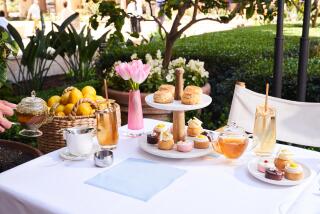COLLECTIBLES : Sentiment Keeps Brewing in Teapots
- Share via
Teapots are like people: They come in all shapes and sizes, each with a distinct personality. Some bear the marks of a shady history, while others have the unmistakable patina of a life surrounded by privilege.
Audrey Heredia thinks this way of the odd and old crockery that she has been collecting since she was a girl. The teapots and assorted teacups and saucers--at least 150 total at last count--sit perched on various shelves and a sideboard in the McCharles House, a restaurant and tea room in Tustin that Audrey and daughter Vivian own and manage.
The venue is something of a shrine to the teapot. Chipped and cracked ones are used as planters in the herb garden. Tucked behind glass shelves are antique tea caddies and English biscuit tins. Tablecloths from the Great Depression bear teapot motifs, and even the old hanging copper sign advertising the place is made in the shape of a teapot.
Almost every flower is represented in these porcelain beauties, with a heavy emphasis on roses and violets, and every country that ever made a teapot, including England, Japan, China, Russia, Mexico and Egypt. Some in the collection bear the mark of such established manufacturers as Wedgwood and Royal Doulton.
Among Heredia’s favorites is a hand-painted teapot shaped like a pumpkin. This squat cutie, bought in an antique store in Washington state years ago, is loaded with personality. Its handle is made in the shape of vines, the body looks like a pumpkin gourd and a tiny round pumpkin decorates the lid top (you can almost hear a giggle when you lift it).
Heredia doesn’t know its value, nor does she know the precise worth of most things in her collection. But then, money isn’t the object here.
“These will always stay in the family. I collect them out of love, not for their value.”
Gloria Crane of Fullerton also places a lot of sentimental value on her teapots--she was given her first one as a child by her grandmother--and has been collecting for 30 years. Among her most prized pieces, valued around $150 each, are elephant-shaped Satsuma teapots--so named for a former province in Japan famous for its porcelain.
They were made during the Showa period (1939 to 1959) out of a chocolate-colored porcelain material decorated with bright-colored paint--giving them a strong Art Deco feel.
Antiques dealer Mary Colby has watched the value of teapots climb steadily in recent years because of a fascination for anything to do with tea--from tea rooms to tea cozies to tea parties. (Yes, there’s even a tea-lover’s magazine.) She notes that a shipment of 100 antique English teapots, scheduled to be delivered this month to the shop bearing Colby’s name in San Clemente, were difficult to find even in England because of growing demand.
That’s because the English make the best teapots--always have, probably always will. Tea drinking, after all, is an institution over there.
Among the most valuable teapots are those from the Victorian era, says Colby, priced anywhere from $125 on up, and bearing the manufacturer’s mark of Rockingham, Derby, Arthur Wood, Chelsea or Wedgwood, to name a few.
This renewed interest in teapots is amusing to Colby. As tea became popular in England, later blooming to craze status, starting about 300 years ago, great value came to be placed on porcelain, furniture or even books associated with the beverage.
Based on her teapot sales, Colby figures another such craze is brewing.
More to Read
Eat your way across L.A.
Get our weekly Tasting Notes newsletter for reviews, news and more.
You may occasionally receive promotional content from the Los Angeles Times.










